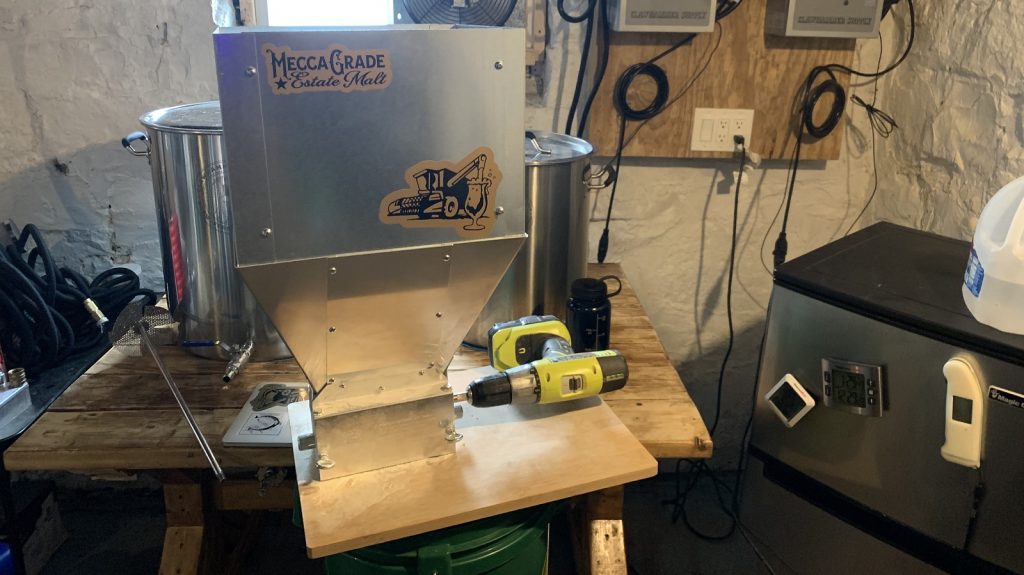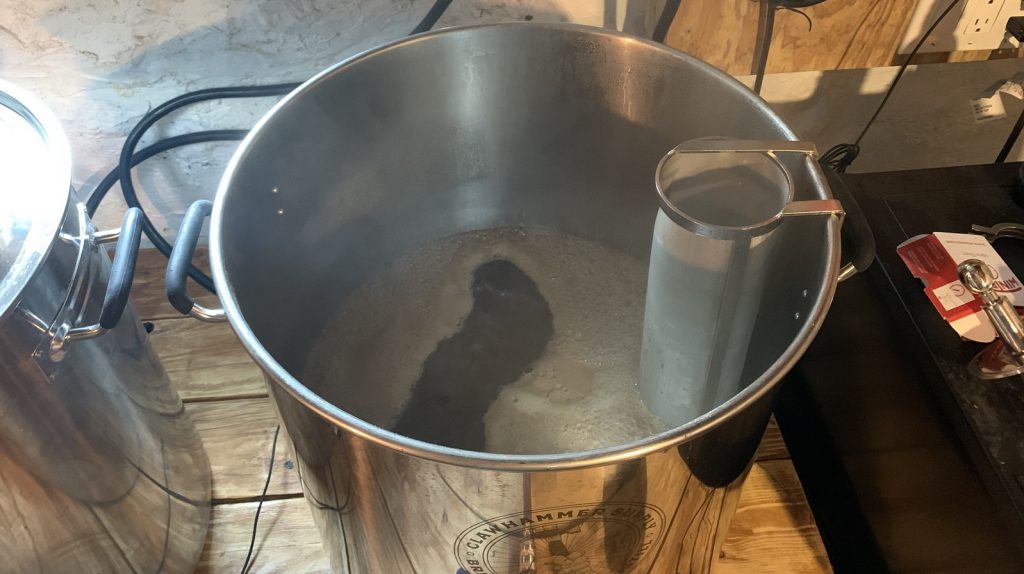Author: Phil Rusher
The most common grain used in the production of beer is barley, particularly of the malted sort, which possesses the necessary enzymes to covert starch into fermentable sugar. However, other cereal grains also have a long history of use in brewing including oats, which is widely believed to contribute a smooth mouthfeel and cookie-like character to beer.
Similar to barley, oats come in various forms with two of the most common being flaked and malted, as both can be added directly to the mash without first performing a cereal mash. Whereas malted oats go through the same malting process as barley, flaked oats are softened with steam or a brief steep in hot water before being run through a roller system to flatten them, which both gelatinizes the starch and increases surface area. Given the accessibility of starches in both flaked and malted oats, many view them as contributing similar enough characteristics as to be used interchangeably, though others claim each is unique.
I’ve brewed many batches of beer with oats, typically sticking with flaked, though I’ve also used malted a handful of times. My anecdotal experience has been that both contribute similar characteristics, which the results from a past xBmt where tasters could not reliably tell apart a NEIPA made with flaked oats from one made with malted oats corroborate. Curious how each would compare in a less hoppy style, I decided to test it out on an American Brown Ale.
| PURPOSE |
To evaluate the differences between an American Brown Ale made with flaked oats and one made with the same proportion of malted oats.
| METHODS |
For this xBmt, I went with an American Brown Ale recipe that I felt would benefit from the use of oats.
BackBurner
Recipe Details
| Batch Size | Boil Time | IBU | SRM | Est. OG | Est. FG | ABV |
|---|---|---|---|---|---|---|
| 6.5 gal | 60 min | 27.3 | 22.3 SRM | 1.062 | 1.006 | 7.35 % |
| Actuals | 1.062 | 1.006 | 7.35 % | |||
Fermentables
| Name | Amount | % |
|---|---|---|
| Super Pale Malt | 11 lbs | 69.29 |
| Oats, Malted | 4 lbs | 25.2 |
| GoldSwaen Brown | 8 oz | 3.15 |
| Black Barley | 6 oz | 2.36 |
Hops
| Name | Amount | Time | Use | Form | Alpha % |
|---|---|---|---|---|---|
| Hallertau Magnum | 15 g | 60 min | Boil | Pellet | 11.1 |
| Jarrylo | 10 g | 25 min | Boil | Pellet | 12.6 |
| Northern Brewer | 15 g | 10 min | Boil | Pellet | 7.5 |
Yeast
| Name | Lab | Attenuation | Temperature |
|---|---|---|---|
| House (A01) | Imperial Yeast | 75% | 32°F - 32°F |
Notes
| Water Profile: Ca 54 | Mg 0 | Na 13 | SO4 60 | Cl 75 |
Download
| Download this recipe's BeerXML file |
A few days prior to brewing, I made a single large starter with two pouches of Imperial Yeast A01 House.
After collecting the water for both batches and adjusting them to my desired profile, I weighed out and milled the grain.
When each water was properly heated, I incorporated the grains then checked to make sure they were at the same target mash temperature.
While the mashes were resting, I prepared the kettle hop additions.
Following each 60 minute mash rest, I removed the grains then proceeded to boil the worts for 60 minutes with hops added at the times stated in the recipe.
Once each 60 minute boil was complete, the worts were quickly chilled on their way to sanitized Ss Brew Buckets.
Refractometer readings showed the wort made with flaked oats was 0.006 SG points lower than the one made with malted oats.

With the worts at my desired fermentation temperature of 63°F/17°C, I evenly split the yeast starter between them. The beers were left to ferment for 4 weeks before I took hydrometer measurements showing the flaked oats beer had a lower FG than the beer made with malted oats.

At this point, I let the beers condition in the FVs at 63°F/17°C for another 3 weeks before racking them to CO2 purged kegs.
The filled kegs were placed in my keezer and burst carbonated overnight before I reduced the gas to serving pressure. After 3 days of conditioning, they were carbonated and ready for evaluation.

| RESULTS |
Due to social distancing practices as a result of the COVID-19 pandemic, data for this xBmt was unable to be collected in our typical manner. As such, temporary adaptations were made involving the author completing multiple semi-blind triangle tests in as unbiased a way as possible.
Utilizing 4 opaque cups of the same color where 2 were inconspicuously marked, one set was filled with beer made with flaked oats while the other set was filled with the beer made with malted oats. For each triangle test, 3 of the 4 cups were indiscriminately selected, thus randomizing which beer was the unique sample for each trial. Following each attempt, I noted whether I was correct in identifying the unique sample. Out of the 10 semi-blind triangle tests I completed, I needed to identify the unique sample at least 7 times (p<0.05) in order to reach statistical significance. In the end, I correctly identified the unique sample 4 times (p=0.44), indicating my inability to reliably distinguish an American Brown Ale made with flaked oats from one made with the same proportion of malted oats.
Despite my intimate familiarity with these beers and the variable, I simply could not tell them apart and was forced to guess on my triangle tests. Both beers were medium bodied and primarily malt forward with deep bready flavors and very restrained roast character, all of which was supported by low earthy, somewhat minty hop notes. I enjoyed both of these beers very much!
| DISCUSSION |
Oats have a long history of use in brewing and are integral to the production of certain styles, though are often used in smaller proportions as a way to not only improve body and head retention, but add a touch of cookie-like flavor to beer. While flaked oats are perhaps most recognizable to brewers, the use of malted oats seems to be growing in popularity, with some claiming each imparts its own unique characteristics. My inability to reliably distinguish an American Brown Ale made with flaked oats from one made with the same proportion of malted oats indicates any differences between the beers were too small for me to perceive.
Despite my inability to tell these beers apart, there was an obvious objective difference between them in terms of both OG and FG that I presumed would be easily perceptible. It’s possible the fact both beers attenuated about the same, resulting in them being just 0.2% ABV apart, explains these results.
Over the years, I’ve used both flaked and malted oats a number of times, and I presumed each contributed its own unique flavors. The results of this xBmt suggest that while malted oats may have an objective impact on OG, it contributes similar perceptible characteristics as flaked oats, which I find quite interesting. Personally, this xBmt has done little to change my thinking about oats and I’ll continue using both types in the future.
If you have any thoughts about this xBmt, please do not hesitate to share in the comments section below!
Support Brülosophy In Style!
All designs are available in various colors and sizes on Amazon!
Follow Brülosophy on:
FACEBOOK | TWITTER | INSTAGRAM
If you enjoy this stuff and feel compelled to support Brulosophy.com, please check out the Support page for details on how you can very easily do so. Thanks!




















7 thoughts on “exBEERiment | Flaked vs. Malted Oats In An American Brown Ale”
Nice article – might have to give your recipe a try for my next dark, sounds delicious. Small niggle – the temperatures for Imperial House yeast are stated as “32°F – 32°F” in your ingredients tables, probably should be “62-70°F”.
Thanks! ’twas indeed delicious 🙂
Right, the fermentation temperature is a plugin issue that happens with 100% of our articles. We’re still trying to figure out what the best solution is for that!
Are you using flaked oats from the HBS or commercial grocery store product? If grocery, what type of oats?
I haven’t bought oats from a homebrew shop in years! I usually use either my store brand old fashioned rolled oats or the Quaker brand. They’re virtually identical.
Did you have any issues milling the Oat Malt? I got some from a local craft maltster and the size of the grain was much more narrow than barley and had to use a very narrow mill gap. Double milled the Oats too.
Yes! I had to tighten up my mill as well. To make things worse, husks seem much less prone to crushing than barley, from what I can tell.
Hi Phil,
the Oat question intrigues me, too. do you know if all regular rolled oats are pre-gelatinized? if you rolled your own oats, e.g. from raw naked oats, would you have to add a cereal mash? Have you ever tried the flaked oats from Crisp that (and hold on to your hat for this one…) still has the hulls on them(!)? they seem to me like they’d be ideal, but unfortunately I haven’t been able to get ahold of them yet.
cheers,
josh